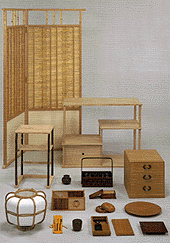 |

|
Kyo Sashimono (joinery works)
 Sashimono refers to the craft of binding together wooden poles and boards. One theory suggests that this word also refers to woodcraft using rulers (monosashi) for measurement. The joinery works in Kyoto include furniture, tea utensils, bent wood works, carvings, sawed pieces and wooden buckets, and much pride is taken in its elegant design and high techniques. Its origin can be traced back to the Heian period among court artisans. However, today, they are produced mostly as carpentry work, though the appearance of professional jointers came about in the Muromachi period with the increase in the types of utensils and in the demand by the upper echelons of society. Moreover, from the time of Sen Rikyu, tea culture greatly influenced the tradition of Kyoto's joinery works. In the Edo period, the names of Fujiki Gonbei for wooden furniture and Komazawa Risai for tea utensils came to be known. The materials and techniques of the pieces created in Kyoto are quite unique and its quality can be easily recognized, making it the apex of high quality Japanese furniture and tea utensils in Japan. Sashimono refers to the craft of binding together wooden poles and boards. One theory suggests that this word also refers to woodcraft using rulers (monosashi) for measurement. The joinery works in Kyoto include furniture, tea utensils, bent wood works, carvings, sawed pieces and wooden buckets, and much pride is taken in its elegant design and high techniques. Its origin can be traced back to the Heian period among court artisans. However, today, they are produced mostly as carpentry work, though the appearance of professional jointers came about in the Muromachi period with the increase in the types of utensils and in the demand by the upper echelons of society. Moreover, from the time of Sen Rikyu, tea culture greatly influenced the tradition of Kyoto's joinery works. In the Edo period, the names of Fujiki Gonbei for wooden furniture and Komazawa Risai for tea utensils came to be known. The materials and techniques of the pieces created in Kyoto are quite unique and its quality can be easily recognized, making it the apex of high quality Japanese furniture and tea utensils in Japan.
BACK


|
|